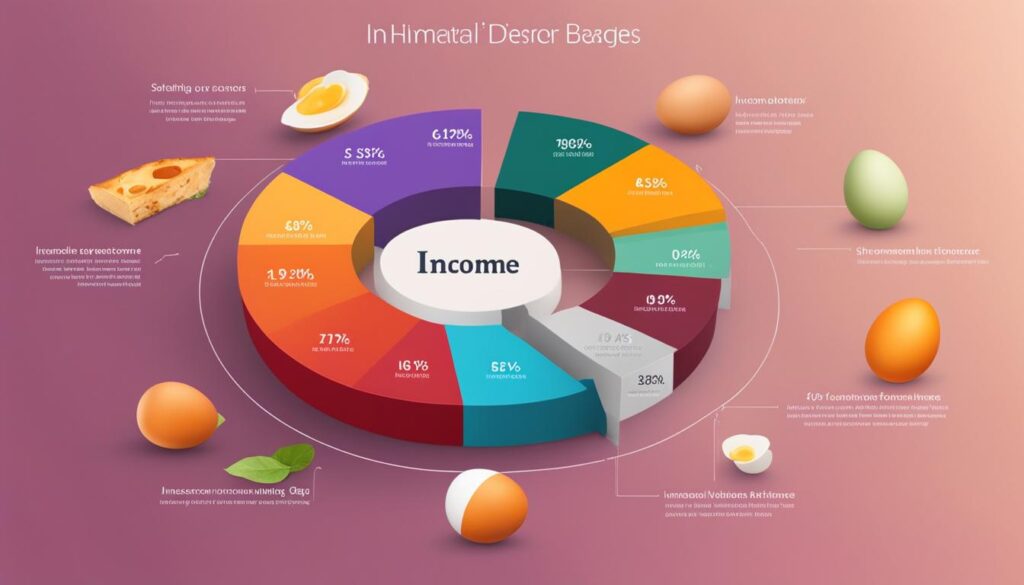Diversifying income sources is crucial for achieving financial stability. By diversifying, you can reduce the risk of losing all your money at once. For example, in 2008, the S&P 500 had a negative return of 37.00%. However, if you had allocated just half of your funds to fixed income, your ending value would have been approximately $84,120. Diversification goes beyond holding different types of investments; it also involves diversifying within the stocks and bonds you hold. This includes allocating to companies in different sectors of the market and diversifying among different types of bonds. Diversification can be challenging, but mutual funds and ETFs offer a way to delegate the research and selection process to professionals.
Key Takeaways:
- Diversifying income sources is crucial for financial stability.
- Diversification reduces the risk of losing all your money at once.
- Allocating funds to different types of investments and within stocks and bonds is important.
- Mutual funds and ETFs can help simplify the diversification process.
- Start diversifying your income sources today for long-term financial success.
Understanding the Importance of Diversification
Diversification is a key component in generating passive income from multiple sources. It involves creating a portfolio that includes various income streams, such as side gigs and investment income. By diversifying your sources of income, you can protect yourself from relying solely on one source, which can be risky, especially during an economic downturn.
Diversification allows you to have a safety net in place, ensuring that even if one source of income underperforms, you have others to rely on. This provides stability and reduces the potential impact of financial hardships. By having multiple income streams, you can create a more secure financial future for yourself and your family.
“Diversification is not just a defensive strategy, it’s an offensive strategy for achieving financial independence.” – Robert Kiyosaki
Investment income is one of the ways to diversify your income. By investing in different assets, such as stocks, bonds, and real estate, you can generate additional income streams. This allows you to benefit from the potential returns of each asset class while spreading the risk.
Overall, understanding the importance of diversification is crucial for achieving financial stability and security. It helps you generate passive income from multiple sources, protecting you from relying solely on one income stream. By diversifying, you can create opportunities for additional income through side gigs and investment income, ensuring a more stable and prosperous financial future.
The Importance of Passive Income
Passive income is generated from sources that require minimal effort to maintain. It provides financial freedom and allows you to have more control over your time. By diversifying your income and including passive income streams, you can create a more balanced and resilient financial portfolio.
Strategies for Diversifying Your Income
Diversifying your income requires strategic planning and careful consideration of your financial goals. When developing an income strategy, it’s important to assess your available resources, risk tolerance, and the amount of time and knowledge you can dedicate to diversification. Here are some key strategies to consider:
1. Delegate to Professionals
If research and selection are not your strengths, consider delegating your investment decisions to a professional manager or utilizing mutual funds and ETFs. These investment vehicles allow you to benefit from the expertise of professionals who actively manage diversified portfolios on your behalf. It’s important to research and choose funds that align with your investment objectives.
2. Diversify Within Investments
Diversification goes beyond holding different types of investments; it also involves diversifying within the stocks and bonds you hold. This includes allocating to companies in different sectors of the market and diversifying among different types of bonds. By spreading your investments across various sectors and asset classes, you can reduce the risk associated with any single investment.
3. Set Limits and Avoid Over-Diversification
While diversification is important, it’s essential to set limits and avoid over-diversification. Over-diversification can decrease potential returns and make it difficult to manage your portfolio effectively. Instead, focus on building a well-diversified portfolio that aligns with your risk tolerance and investment goals.
By implementing these strategies, you can effectively diversify your income sources and work towards achieving your financial goals. Remember to regularly review and adjust your portfolio as needed to ensure that it remains aligned with your changing circumstances and objectives.

The Role of Asset Allocation in Diversification
When it comes to diversifying your income sources, asset allocation plays a crucial role in achieving financial independence and navigating economic downturns. Asset allocation involves distributing your investments across different asset classes, such as stocks, bonds, real estate, and currencies, to minimize risk and maximize returns. By diversifying across various asset classes, you can mitigate the impact of market volatility and economic downturns, ensuring a more stable and secure financial future.
Diversification and Financial Independence
One of the key benefits of asset allocation is that it helps you achieve financial independence. By spreading your investments across different asset classes and sectors, you can generate income from multiple sources, reducing your reliance on a single income stream. This diversification allows you to not only protect your investments but also create additional sources of income that can sustain you during challenging times.
During an economic downturn, some asset classes may underperform while others may thrive. For example, stocks may experience a downturn, but bonds or real estate investments may remain stable or even increase in value. By diversifying your portfolio, you can potentially offset losses in one area with gains in another, helping you maintain your financial stability and independence.
The Importance of Strategic Asset Allocation
Strategic asset allocation is a critical component of diversification. It involves carefully selecting and balancing different asset classes based on factors such as your risk tolerance, retirement income needs, and available resources. By considering these factors and strategically allocating your investments, you can optimize your portfolio’s performance and reduce vulnerability to market volatility.
When implementing strategic asset allocation, it’s important to conduct thorough research and analysis to understand the characteristics and potential risks of each asset class. This will help you make informed decisions about how much to allocate to each asset class and ensure that your investments align with your long-term financial goals.
Remember, asset allocation is not a one-time decision. It requires ongoing monitoring and adjustments to ensure that your portfolio remains diversified and aligned with your changing financial circumstances and goals.

In summary, asset allocation is a key strategy for diversifying your income sources and achieving financial independence. By spreading your investments across different asset classes, you can mitigate the impact of market volatility and economic downturns, creating a more stable and secure financial future. Strategic asset allocation, along with careful research and analysis, ensures that your portfolio is optimized for long-term performance. Start implementing asset allocation strategies today to enhance your income diversification and build a solid foundation for financial success.
Conclusion
Income diversification is integral to achieving financial stability and implementing a successful investment strategy. By diversifying your income sources, you can minimize the risk of relying solely on one income stream and create opportunities for additional sources of revenue. This approach not only provides financial stability, but also safeguards against the impact of market fluctuations and economic downturns.
Strategic asset allocation is a crucial aspect of diversification. By distributing your portfolio investments across different asset classes, such as stocks, bonds, real estate, and currencies, you can mitigate the effects of market volatility and achieve long-term financial success. Moreover, diversifying within investments, including allocating funds to companies in various market sectors and different types of bonds, further enhances your ability to weather economic uncertainties.
When implementing an income diversification strategy, it is important to consider your financial goals, time availability, and knowledge. Delegating to professionals, using mutual funds and exchange-traded funds (ETFs), can simplify the process and ensure alignment with your investment objectives. Additionally, consolidating accounts across different firms can streamline portfolio management and improve overall performance.
Start planning your income diversification strategy today to build a strong financial foundation and secure a comfortable retirement. By diversifying your income sources and adopting a thoughtful investment approach, you can strive for financial stability, protect against potential hardships, and achieve long-term financial independence.
FAQ
Why is diversifying income sources important?
Diversifying income sources is crucial for achieving financial stability. It reduces the risk of relying on a single income stream and provides opportunities for additional sources of income.
What are some ways to diversify income?
You can diversify income through side gigs, investment income, and other means. By creating multiple streams of income, you can generate passive income and mitigate the impact of market fluctuations.
How can mutual funds and ETFs help with diversification?
Mutual funds and ETFs allow you to delegate the research and selection process to professionals. They offer a way to diversify within investments and can provide stability and protection against potential financial hardships.
What role does asset allocation play in diversification?
Asset allocation involves distributing your portfolio investments among different asset classes. By diversifying across various asset classes, such as stocks, bonds, real estate, and currencies, you can minimize the impact of market volatility and economic downturns.
How do I start diversifying my income?
Start by making a decision on how much time and knowledge you have to dedicate to diversification. If research and selection are not your strengths, consider delegating to a manager or using mutual funds and ETFs. Set limits, consolidate accounts, and ensure that your investment objectives align with the funds you choose.
How Can Diversifying Your Income Contribute to Side Hustle Success During a Downturn?
Diversifying your income is a smart strategy for thriving with extra income during downturns. By having multiple streams of revenue, you can lessen the impact of a downturn on your finances. Side hustles add an additional layer of security, allowing you to make money even when your primary source of income is affected. Embracing diverse income sources increases your chances of side hustle success during challenging times.

